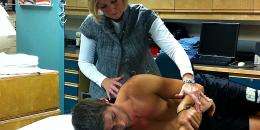Getting back in the game: 'Sleeper' shoulder stretch

Researchers at the University of Alberta have found that the "sleeper" shoulder stretch is actually just what varsity athletes need to improve shoulder rotation and get back in the game.
Physical therapist Judy Chepeha, a researcher in the Faculty of Rehabilitation Medicine, compared 66 varsity level athletes from the U of A’s volleyball, tennis and swim teams with 30 non-competitive university students to gauge their shoulder rotation.
The research showed that more than 65 per cent of the varsity athletes had an altered-shoulder rotation pattern known to place some athletes at risk of shoulder injury.
“Tightness in this region of the shoulder has been noted in athletes who participate in repetitive, overhead rotation movements often found in sports such as volleyball, baseball, swimming and tennis,” said Chepeha. “It is suggested to be a potential risk factor in the development of shoulder injuries in this population.”
Chepeha also tested the effectiveness of the sleeper stretch over an eight-week time period.
The sleeper stretch is performed by lying directly on the side of the shoulder that is to be stretched. The shoulder is bent or flexed to 90 degrees and the elbow is also bent to 90 degrees. The hand of the non-stretching arm is placed just above the wrist, and a gentle pressure is applied in a downward (internal rotation) direction until a “good stretch is felt, but not pain.”
“The sleeper stretch is designed to stretch the posterior region of the shoulder, including the posterior joint capsule and rotator cuff musculature,” said Chepeha.
Overhead athletes who performed the shoulder stretch showed an 80 per cent increase in shoulder rotation compared to athletes who did not stretch. Also, athletes who used the stretch reported an overall increase in shoulder function over the eight-week treatment time.
“The sleeper stretch is effective and improvement was reported as early as four weeks,” Chepeha says.
Jarron Mueller, a U of A Golden Bears’ volleyball player who took part in the study, reported improvements in his shoulder function after performing the stretch exercise.
“You get more shoulder movement and feel more flexible, which is a bonus in sports. Doing the stretch can prevent injuries, which is important because you don’t want to miss games due to soreness or stiffness in the shoulder.”
Chepeha recently successfully defended this study in her PhD.
















